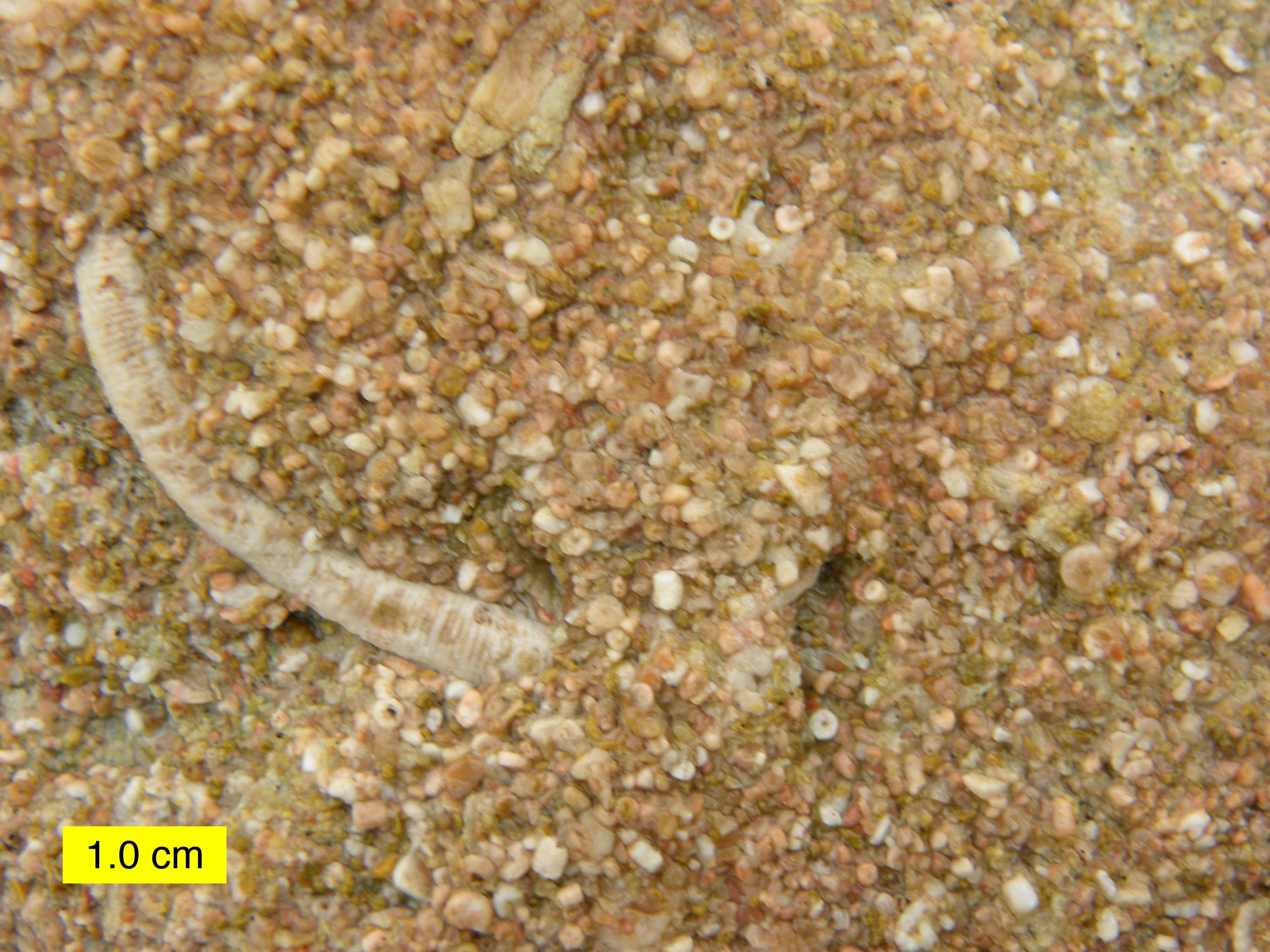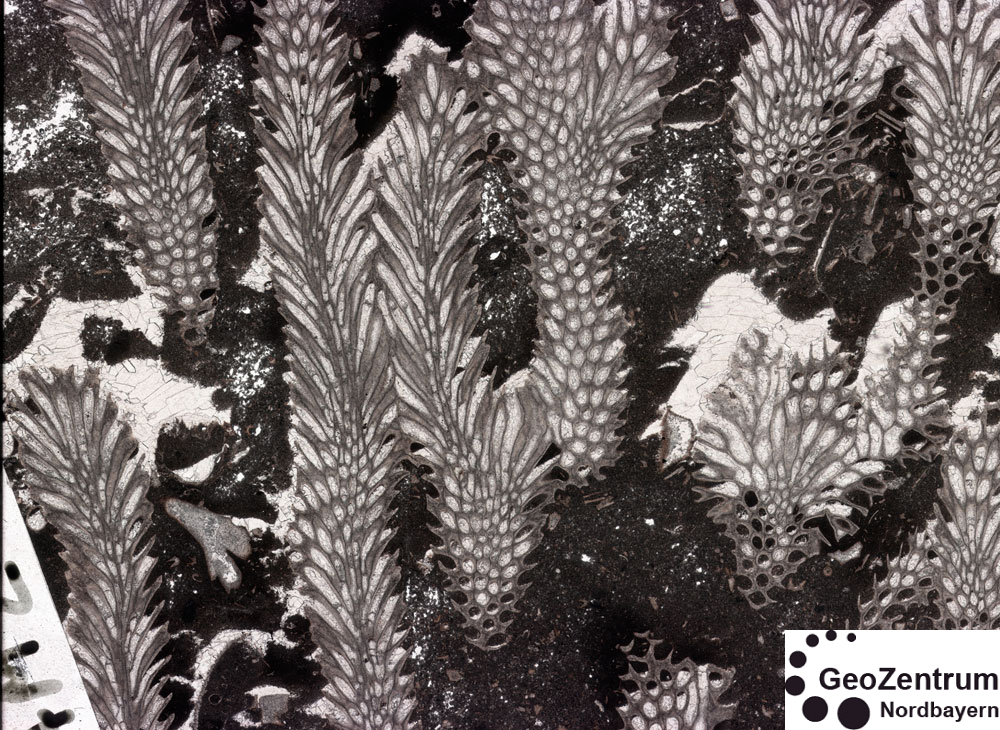|
Dunham Classification
The Dunham classification system for carbonate sedimentary rocks was originally devised by Robert J. Dunham in 1962, and subsequently modified by Embry and Klovan in 1971 to include coarse-grained limestones and sediments that had been organically bound at the time of deposition. The ''modified Dunham Classification'' has subsequently become the most widely employed system for the classification of carbonate sedimentary rocks with 89% of workers currently adopting this system over the alternative Folk classification scheme History Original classification Robert J. Dunham published his classification system for limestone in 1962. The original Dunham classification system was developed in order to provide convenient depositional-texture based class names that focus attention on the textural properties that are most significant for interpreting the depositional environment of the rocks. The three criteria used to define the original Dunham classes were: * the supporting fabric ... [...More Info...] [...Related Items...] OR: [Wikipedia] [Google] [Baidu] |
Wackestone
Under the Dunham classification (Dunham, 1962Dunham, R.J., 1962. Classification of carbonate rocks according to depositional texture. In: W.E. Ham (Ed.), Classification of Carbonate Rocks. American Association of Petroleum Geologists Memoir. American Association of Petroleum Geologists, Tulsa, Oklahoma, pp. 108–121.) system of limestones, a wackestone is defined as a mud-supported carbonate rock that contains greater than 10% grains. Most recently, this definition has been clarified as ''a carbonate-dominated rock in which the carbonate mud (2 mm)''. The identification of wackestone A study of the adoption and use of carbonate classification systems by Lokier and Al Junaibi (2016) highlighted that the most common problem encountered when describing a wackestone is to incorrectly estimate the volume of 'grains' in the sample – in consequence, misidentifying wackestone as mudstone Mudstone, a type of mudrock, is a fine-grained sedimentary rock whose original constituents ... [...More Info...] [...Related Items...] OR: [Wikipedia] [Google] [Baidu] |
Sedimentary Rocks
Sedimentary rocks are types of rock that are formed by the accumulation or deposition of mineral or organic particles at Earth's surface, followed by cementation. Sedimentation is the collective name for processes that cause these particles to settle in place. The particles that form a sedimentary rock are called sediment, and may be composed of geological detritus (minerals) or biological detritus (organic matter). The geological detritus originated from weathering and erosion of existing rocks, or from the solidification of molten lava blobs erupted by volcanoes. The geological detritus is transported to the place of deposition by water, wind, ice or mass movement, which are called agents of denudation. Biological detritus was formed by bodies and parts (mainly shells) of dead aquatic organisms, as well as their fecal mass, suspended in water and slowly piling up on the floor of water bodies ( marine snow). Sedimentation may also occur as dissolved minerals precipit ... [...More Info...] [...Related Items...] OR: [Wikipedia] [Google] [Baidu] |
Framestone
A framestone is a special type of carbonate rock in the Dunham classification. Description The term "framestone" was not used in the original Dunham classification by Dunham (1962). It first appeared in the modified Dunham classification by Embry and Klovan (1971) where it is described as an autochthonous limestone having "in situ massive fossils which constructed a rigid three-dimensional framework during deposition. The in situ fossils therefore form the supporting framework of the rock, with matrix material occurring in the interstices between the fossils." Lokier and Al Junaibi(2016) define a framestone as "an autochthonous carbonate-dominated rock supported by a rigid organic framework developed at the time of deposition." Interpretive problems One possible problem in the interpretation of framestones is that the framework can be of different sizes from millimeters to meters, so they might not be present on the thin section. Some organisms can also be binding and build ... [...More Info...] [...Related Items...] OR: [Wikipedia] [Google] [Baidu] |
Bindstone
Bindstone is a special type of carbonate rock in the Dunham classification. The term did not appear in the original Dunham classification from 1962 and was introduced by Embry and Klovan 1971 in the modified Dunham classification. Description Embry and Klovan(1971) define bindstones as rocks that " ..contain in situ, tabular or lamellar fossils which encrusted and bound sediment during deposition. ..The matrix, not the in situ fossils, forms the supporting framework of the rock, and the fossils may form as little as 15 percent of the constituents of the rock." Wright (1991) uses bindstone as a synonym for boundstone, which is defined as a rock " ..where the structure reflects the encrusting and binding action of plants or animals" Lokier and Al Nunaibi (2016) define bindstones as "autochthonous carbonate-dominated rock in which the original components of the supporting matrix were organically bound through stabilization of the sediment at the time of deposition." Problems On ... [...More Info...] [...Related Items...] OR: [Wikipedia] [Google] [Baidu] |
Bafflestone
Bafflestone is a type of carbonate rock. The Dunham Classification (Dunham, 1962) of limestones Limestone ( calcium carbonate ) is a type of carbonate sedimentary rock which is the main source of the material lime. It is composed mostly of the minerals calcite and aragonite, which are different crystal forms of . Limestone forms when t ... employed the term boundstone to encompass all carbonate rocks that exhibited any evidence of the original components being organically-bound together at the time of deposition. Embry & Klovan (1971Embry, A.F. and Klovan, J.E. (1971) A Late Devonian reef tract on Northeastern Banks Island, NWT. Bull. Can. Pet. Geol., 19, 730–781.) proposed the sub-division of the boundstone classification in order to reflect the different mechanisms of binding within these autochthonous carbonate sediments. The classification ''bafflestone'' was proposed to describe sediments that formed where organic baffling resulted in a reduction in flow and a conse ... [...More Info...] [...Related Items...] OR: [Wikipedia] [Google] [Baidu] |
Rudstone
Rudstone is a type of carbonate rock. The Dunham classification (Dunham, 1962) did not consider grain size as a criterion for the description of carbonate lithologies. In an attempt to rectify this perceived deficiency, Embry & Klovan (1971) introduced the terms ''rudstone'' (grain supported) and '' floatstone'' (matrix Matrix most commonly refers to: * ''The Matrix'' (franchise), an American media franchise ** '' The Matrix'', a 1999 science-fiction action film ** "The Matrix", a fictional setting, a virtual reality environment, within ''The Matrix'' (franchi ... supported) for coarse-grained allochthonous carbonates. Following a survey of the use of the Dunham classification, Lokier and Al Junaibi (2016) clarified the definition of a rudstone as "''a carbonate-dominated rock where more than 10% of the volume is {{sic, comprised , hide=y, of grains larger than 2 mm and these grains support the fabric of the rock."'' References Limestone ... [...More Info...] [...Related Items...] OR: [Wikipedia] [Google] [Baidu] |
Floatstone
Floatstone is a type of carbonate rock. The original Dunham classification (Dunham, 1962) of limestone Limestone ( calcium carbonate ) is a type of carbonate sedimentary rock which is the main source of the material lime. It is composed mostly of the minerals calcite and aragonite, which are different crystal forms of . Limestone forms w ...s did not consider the separate classification of coarse grained carbonate lithologies. In an attempt to rectify this, Embry & Klovan (1971Embry, A.F. and Klovan, J.E. (1971) A Late Devonian reef tract on Northeastern Banks Island, NWT. Bull. Can. Pet. Geol., 19, 730–781.) introduced the terms rudstone (grain supported) and floatstone (matrix supported) for coarse-grained allochthonous limestones. This definition of a floatstone was most recently clarified as "a carbonate-dominated rock where more than 10% of the volume is grains larger than 2 mm and the fabric is supported by the component that is 2 mm and smaller". References ... [...More Info...] [...Related Items...] OR: [Wikipedia] [Google] [Baidu] |
5 X2 PPL
5 (five) is a number, numeral and digit. It is the natural number, and cardinal number, following 4 and preceding 6, and is a prime number. It has attained significance throughout history in part because typical humans have five digits on each hand. In mathematics 5 is the third smallest prime number, and the second super-prime. It is the first safe prime, the first good prime, the first balanced prime, and the first of three known Wilson primes. Five is the second Fermat prime and the third Mersenne prime exponent, as well as the third Catalan number, and the third Sophie Germain prime. Notably, 5 is equal to the sum of the ''only'' consecutive primes, 2 + 3, and is the only number that is part of more than one pair of twin primes, ( 3, 5) and (5, 7). It is also a sexy prime with the fifth prime number and first prime repunit, 11. Five is the third factorial prime, an alternating factorial, and an Eisenstein prime with no imaginary part and real part of the form 3 ... [...More Info...] [...Related Items...] OR: [Wikipedia] [Google] [Baidu] |
13 X2 PPL
Thirteen or 13 may refer to: * 13 (number), the natural number following 12 and preceding 14 * One of the years 13 BC, AD 13, 1913, 2013 Music * 13AD (band), an Indian classic and hard rock band Albums * ''13'' (Black Sabbath album), 2013 * ''13'' (Blur album), 1999 * ''13'' (Borgeous album), 2016 * ''13'' (Brian Setzer album), 2006 * ''13'' (Die Ärzte album), 1998 * ''13'' (The Doors album), 1970 * ''13'' (Havoc album), 2013 * ''13'' (HLAH album), 1993 * ''13'' (Indochine album), 2017 * ''13'' (Marta Savić album), 2011 * ''13'' (Norman Westberg album), 2015 * ''13'' (Ozark Mountain Daredevils album), 1997 * ''13'' (Six Feet Under album), 2005 * ''13'' (Suicidal Tendencies album), 2013 * ''13'' (Solace album), 2003 * ''13'' (Second Coming album), 2003 * ''13'' (Ces Cru EP), 2012 * ''13'' (Denzel Curry EP), 2017 * ''Thirteen'' (CJ & The Satellites album), 2007 * ''Thirteen'' (Emmylou Harris album), 1986 * ''Thirteen'' (Harem Scarem album), 2014 * ''Thirtee ... [...More Info...] [...Related Items...] OR: [Wikipedia] [Google] [Baidu] |
Thin Section
In optical mineralogy and petrography, a thin section (or petrographic thin section) is a thin slice of a rock or mineral sample, prepared in a laboratory, for use with a polarizing petrographic microscope, electron microscope and electron microprobe. A thin sliver of rock is cut from the sample with a diamond saw and ground optically flat. It is then mounted on a glass slide and then ground smooth using progressively finer abrasive grit until the sample is only 30 μm thick. The method uses the Michel-Lévy interference colour chart to determine thickness, typically using quartz as the thickness gauge because it is one of the most abundant minerals. When placed between two polarizing filters set at right angles to each other, the optical properties of the minerals in the thin section alter the colour and intensity of the light as seen by the viewer. As different minerals have different optical properties, most rock forming minerals can be easily identified. Plagioclase ... [...More Info...] [...Related Items...] OR: [Wikipedia] [Google] [Baidu] |
Autochthon (geology)
An autochthon in structural geology is a large block or mass of rock which is in the place of its original formation relative to its basement or foundation rock. It can be described as rooted to its basement rock as opposed to an allochthonous block or nappe which has been relocated from its site of formation. image:thrust system en.jpg, upright=1.6, Schematic overview of a thrust system. The hanging wall block is (when it has reasonable proportions) called a nappe In geology, a nappe or thrust sheet is a large sheetlike body of rock that has been moved more than or above a thrust fault from its original position. Nappes form in compressional tectonic settings like continental collision zones or on the ... which overlays the autochthonous (unrelocated) material. A hole in the nappe which exposes the underlying autochthonous material is called a window. A klippe is a solitary outcrop of the nappe in the middle of autochthonous material. While an autochthon may have experi ... [...More Info...] [...Related Items...] OR: [Wikipedia] [Google] [Baidu] |







